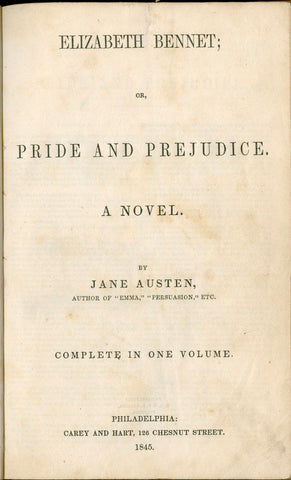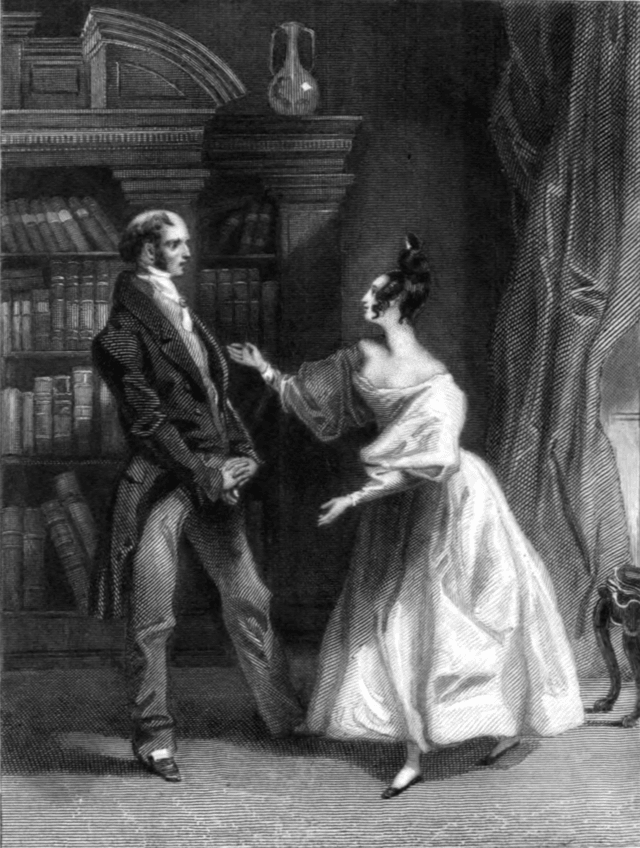Pride and Prejudice: An Overview
First published on the 28th of January in 1813, Pride and Prejudice was Jane Austen's second novel to be printed and its manuscript was initially written between 1796 and 1797 in Steventon, Hampshire. Austen completed the manuscript when she lived in the rectory and originally titled the novel First Impressions. On November 1, 1797, Austen's father gave the draft to the London bookseller Thomas Cadell in the hopes of it being published, but Cadell rejected the novel. The unpublished manuscript was returned to Austen and stayed in her possession for some time.
Austen revised the manuscript for First Impressions, with significant revisions between 1811–1812, and renamed the story Pride and Prejudice. In renaming the novel, Austen probably had in mind the "sufferings and oppositions" summarized in the final chapter of Fanny Burney's Cecilia, called "Pride and Prejudice", where the phrase appears three times in block capitals. It is possible that the novel's original title was altered to avoid confusion with other works. In the years between the completion of First Impressions and its revision into Pride and Prejudice, two other works had been published under that name: a novel by Margaret Holford and a comedy by Horace Smith.
Austen sold the copyright for the novel to Thomas Egerton of Whitehall in exchange for £110 (Austen had asked for £150). This proved a costly decision. Austen had published Sense and Sensibility on a commission basis, whereby she indemnified the publisher against any losses and received any profits, less costs and the publisher's commission. Unaware that Sense and Sensibility would sell out its edition, making her £140, she passed the copyright to Egerton for a one-off payment, meaning that all the risk (and all the profits) would be his. Jan Fergus has calculated that Egerton subsequently made around £450 from just the first two editions of the book. Egerton published the first edition of Pride and Prejudice in three hardcover volumes in January 1813, priced at 18s, with a second edition published in November that year. A third edition was published in 1817.
The novel was well received, with three favourable reviews in the first months following publication. Jan Fergus calls it "her most popular novel, both with the public and with her family and friends", and quotes David Gilson's A Bibliography of Jane Austen (Clarendon, 1982), where it is stated that Pride and Prejudice was referred to as "the fashionable novel" by Anne Isabella Milbanke, later to be the wife of Lord Byron. However, others did not agree. Charlotte Brontë wrote to noted critic and reviewer George Henry Lewes after reading his review published in Fraser's Magazine, in 1847.
He had praised Jane Austen's work and declared that he,
"...would rather have written Pride and Prejudice, or Tom Jones, than any of the Waverley Novels".
Miss Brontë, though, found Pride and Prejudice a disappointment, "...a carefully fenced, highly cultivated garden, with neat borders and delicate flowers; but... no open country, no fresh air, no blue hill, no bonny beck."
Foreign language translations of Pride and Prejudice first appeared in 1813 in French and subsequent translations were published in German, Danish and Swedish. Pride and Prejudice was first published in the United States in August 1832 as Elizabeth Bennet or, Pride and Prejudice. The novel was also included in Richard Bentley's Standard Novel series in 1833. R. W. Chapman's scholarly edition of Pride and Prejudice, first published in 1923, has become the standard edition from which many modern publications of the novel are based.

Many critics take the novel's title as a starting point when analysing the major themes of Pride and Prejudice; however, Robert Fox cautions against reading too much into the title since commercial factors may have played a role in its selection. "After the success of Sense and Sensibility, nothing would have seemed more natural than to bring out another novel of the same author using again the formula of antithesis and alliteration for the title. It should be pointed out that the qualities of the title are not exclusively assigned to one or the other of the protagonists; both Elizabeth and Darcy display pride and prejudice." A major theme in much of Austen's work is the importance of environment and upbringing on the development of young people's character and morality.
Social standing and wealth are not necessarily advantages in her world, and a further theme common to Jane Austen's work is ineffectual parents. In Pride and Prejudice, the failure of Mr. and Mrs. Bennet (particularly the latter) as parents is blamed for Lydia's lack of moral judgment; Darcy, on the other hand, has been taught to be principled and scrupulously honourable, but is also proud and overbearing. Kitty, rescued from Lydia's bad influence and spending more time with her older sisters after they marry, is said to improve greatly in their superior society. Pride and Prejudice, like most of Jane Austen's works, employs the narrative technique of free indirect speech. This has been defined as "the free representation of a character's speech, by which one means, not words actually spoken by a character, but the words that typify the character's thoughts, or the way the character would think or speak, if she thought or spoke". By using narrative which adopts the tone and vocabulary of a particular character (in this case, that of Elizabeth), Austen invites the reader to follow events from Elizabeth's viewpoint, sharing her prejudices and misapprehensions. "The learning curve, while undergone by both protagonists, is disclosed to us solely through Elizabeth's point of view and her free indirect speech is essential... for it is through it that we remain caught, if not stuck, within Elizabeth's misprisions."
Plot Summary
Elizabeth Bennet, one of the five daughters of a country gentleman in 19th Century Hertfordshire England, faces a dilemma in her future -- as their father's property is entailed to a male heir upon his death, they will be turned out of their house and left to fend for themselves unless she and her sisters can find advantageous husbands, something which consumes her mother. An opportunity arrives in the form of Mr. Bingley, a young gentleman of London who takes a country estate near to the Bennet's home, accompanied by his sister and his good friend Fitzwilliam Darcy. Whereas Bingley is well-liked in the community, Darcy begins his acquaintance with Elizabeth, her family, and their neighbours with smug condescension and proud distaste for the all of the country people; despite Mrs. Bennet's embarrassing interference Mr. Bingley and Jane begin to grow closer.
Elizabeth, stung by Darcy's haughty rejection of her at a local dance, makes it a point to match his coldness with her own venom. When the militia arrive in the town, earning the admiration of Elizabeth's flighty and immature younger sisters, Elizabeth begins a friendship with Mr. Wickham, a charming soldier with a prior acquaintance with Darcy. Upon hearing Wickham's story that Darcy broke a promise to his father (a friend of Wickham's father) to provide Wickham with a living after his death. Without thinking through the story, Elizabeth immediately seizes upon it as another, more concrete reason to hate Mr. Darcy. Darcy, for his part, finds himself gradually drawn to Elizabeth.
When Bingley leaves the countryside suddenly and makes no attempts to contact Jane anymore, the young woman is heartbroken. Elizabeth, having previously thought well of Bingley, believes that there is something amiss in the way that he abandoned Jane and suspects Darcy's involvement. She is also approached by her cousin, the foolish and pompous clergyman Mr. Collins, who offers marriage to her; despite the fact that Collins is the male heir who will inherit her father's property upon his death, Elizabeth is unwilling to subject herself to a union that she knows will be unhappy for her and refuses him, much to her mother's distress. Collins subsequently marries Elizabeth's friend Charlotte Lucas, who invites Elizabeth to stay with them. Collins' parish is adjacent to Rosings Park, the grand manor of Darcy's aunt Lady Catherine de Burgh, whom Collins is greatly obsequious towards; as a result, Elizabeth is frequently invited to Rosings, where she is again forced into contact with Darcy, who is visiting his aunt at the time.
During this time, Elizabeth learns that Darcy indeed played a part in separating Bingley and Jane. Elizabeth is shocked when Darcy admits his love for her and proposes marriage. Insulted by his high-handed and insulting manner of proposal, Elizabeth refuses him, confronting him with his sabotage of Bingley's relationship with Jane and Wickham's account of their dealings. Shocked by Elizabeth's vehemence towards him, Darcy writes her a letter justifying his actions and revealing that Wickham in fact cheated him, and attempted to seduce his younger sister Georgiana in the process. He also justifies his actions towards Bingley and Jane with the defence that Jane did not visibly show any interest in his friend, whom he was attempting to protect from both heartache and a disadvantageous association with Elizabeth's embarrassing and uncouth mother and younger sisters; Elizabeth is prompted to question both her family's behaviour and Wickham's credibility, and comes to the conclusion that Wickham is not as trustworthy as his easy manners would indicate and her early impressions of Darcy may not have been accurate.
During a tour of Derbyshire with her aunt and uncle, Elizabeth visits Pemberley, Darcy's grand estate, and presented with a more flattering, benevolent impression of his character from the locals who know him. When the party encounters Darcy when touring the grounds of Pemberley, he makes an effort to behave in a gracious and welcoming manner towards them, thus strengthening Elizabeth's improved attitude. Elizabeth and Darcy's renewed acquaintance is threatened when news arrives that Wickham and Elizabeth's reckless younger sister Lydia have eloped, thus threatening the family's reputation and the Bennet sisters with ruin. Lydia and Wickham are soon found and married, delighting Mrs. Bennet.
Elizabeth is surprised to learn from Lydia that Mr. Darcy was secretly responsible for both finding the couple and arranging their marriage at great expense to himself. Soon after, Bingley and Darcy return to the area; Bingley proposes marriage to Jane, and this news prompts rumours that Darcy will propose to Elizabeth, prompting Lady Catherine confront Elizabeth and imperiously demand that she never accept such a proposal. Elizabeth's refusal to bow to Lady Catherine's demands convinces Darcy that her opinion towards him has changed, and he once again proposes marriage; Elizabeth, who is now in love with Mr. Darcy as well; accepts, and the two are married.
If you have enjoyed this overview of Pride and Prejudice, do take a look at the editions we have at our Online Gift Shop, from collector's specials to those for first time readers of Jane Austen. We adore this illustrated edition of Pride and Prejudice, designed by esteemed artist Marjolein Bastin!
Bibliography and further reading:
Le Faye, Deidre (2002). Jane Austen: The World of Her Novels. New York: Harry N. Abrams. ISBN 0-8109-3285-7.
Rogers, Pat (ed.) (2006), The Cambridge Edition of the Works of Jane Austen: Pride and Prejudice. Cambridge University Press. ISBN 978-0-521-82514-6.
Pinion, F B (1973), A Jane Austen. Companion. Macmillan. ISBN 333-12489-8.
Stafford, Fiona (2004). "Notes on the Text". Pride and Prejudice. Oxford World's Classics (ed. James Kinley). Oxford: Oxford University Press. ISBN 0-19-280238-0.
Fergus, Jan (1997). "The professional woman writer". in E Copeland & J McMaster. The Cambridge Companion to Jane Austen. Cambridge University Press. ISBN 0-521-49867-8.
Miles, Robert (2003). Jane Austen. Writers and Their Work. Northcote House. ISBN 0-7463-0876-0.
Fox, Robert C. (September 1962). "Elizabeth Bennet: Prejudice or Vanity?". Nineteenth-Century Fiction (University of California Press) 17 (2): 185–187. doi:10.1525/ncl.1962.17.2.99p0134x.
Cossy, Valérie and Diego Saglia. "Translations". Jane Austen in Context. Ed. Janet Todd. Cambridge: Cambridge University Press, 2005. ISBN 0-521-82644-6.
Southam, B. C. (ed) (1995). Jane Austen: The Critical Heritage. 1. New York: Routledge. ISBN 978-0-415-13456-9.




